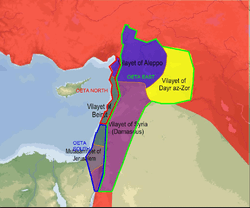Occupied Enemy Territory Administration
| Occupied Enemy Territory Administration | |||||||||||||||||||||||||
|---|---|---|---|---|---|---|---|---|---|---|---|---|---|---|---|---|---|---|---|---|---|---|---|---|---|
| 1917–1920 | |||||||||||||||||||||||||
|
Flag | |||||||||||||||||||||||||
 Area of the Occupied Enemy Territory Administration in Syria and Palestine | |||||||||||||||||||||||||
| Status | Occupied territory | ||||||||||||||||||||||||
| Common languages | Arabic, Ottoman Turkish, French, English | ||||||||||||||||||||||||
| History | |||||||||||||||||||||||||
• Established | 1917 | ||||||||||||||||||||||||
• San Remo conference | 19 to 26 April 1920 | ||||||||||||||||||||||||
• Disestablished | 1920 | ||||||||||||||||||||||||
| |||||||||||||||||||||||||
| Today part of |
| ||||||||||||||||||||||||
The Occupied Enemy Territory Administration (OETA) was a joint British and French military administration over Levantine and Mesopotamian provinces of the former Ottoman Empire between 1918–20, set up following the Sinai and Palestine Campaign of World War I. It was initially set up via the 1918 Anglo–French Modus Vivendi.
The administration ended following the assignment of the French Mandate of Syria and Lebanon and British Mandate for Palestine at the 19–26 April 1920 San Remo conference.
History
Following British and French occupation, the region was split into three administrative sub-units, which varied very little from the previous Ottoman divisions.[1] OETA South, consisting of the Ottoman Mutasarrifate of Jerusalem and the sanjaks of Nablus and Acre, OETA North (later renamed OETA West) consisting of the Ottoman sanjaks of Beirut, Lebanon, Latakia and a number of sub-districts, and OETA East consisting of the Ottoman Syria Vilayet and Hejaz Vilayet. But, success of Turkish War of Independence, Maraş, Antep and Urfa sanjaks of former Halep Eyalet remained in Turkey after 1921. Also, Antakya and İskenderun kazas of Halep Sanjak in one were separated as the Republic of Hatay in 1938. The republic joined to Turkey in 1939.
When the British forces occupied Ethiopia, Libya and other Italian colonies during World War II, the OETA was revived as the administrative structure by which the British governed these territories.[2] In Ethiopia, Emperor Haile Selassie was allowed to return and claim his throne, but the OETA authorities ruled the country for some time before full sovereignty was restored to Ethiopia.
Military administrators
When Field Marshal Edmund Allenby first assumed command of the Egyptian Expeditionary Force he quickly joined the army in the field leaving the political and administrative problems related to the Egyptian Mandate to a Government appointee with a suitable staff. The area of formerly Ottoman territory now under occupation also required management, and with the approval of the Government, Allenby appointed a Chief Administrator for Palestine.[3] He divided the country into four districts: Jerusalem, Jaffa, Majdal and Beersheba, each under a military governor. Under this administration the immediate needs of the people were provided for, seed grain and live–stock were imported and distributed, finance on easy terms was made available through the Army bankers, a stable currency was set up and postal services restored.[4] Allenby insisted that as long as military administration was required, it was to remain his responsibility.[5]
OETA South Chief Administrators
- Major General Arthur Wigram Money (June 1918 – June 1919)
- Major General Harry D. Watson (June 1919 – December 1919)
- Lieutenant-General Louis Bols (January 1920 – July 1920)
OETA East
OETA East was a joint Arab-British military administration. The Arab and British armies entered Damascus on 1 October 1918, and on 3 October 1918 Ali Rida al-Rikabi was appointed Military Governor of OETA East.[6][7] Prince Faisal son of King Hussain of Mecca entered Damascus as on 4 October and appointed Rikabi Chief of the Council of Directors (i.e. prime minister) of Syria.
References
- ↑ Israel: the first hundred years, Efraim Karsh
- ↑ Harold G. Marcus. Haile Selassie and Italians, 1941–1943. Northeast African Studies, Vol. 10, No. 3 (New Series) 2003, pp. 19–25. (Online version of the article).
- ↑ Roberto Mazza (30 September 2009). Jerusalem: From the Ottomans to the British. I.B.Tauris. pp. 148–. ISBN 978-0-85771-393-3.
- ↑ Keogh, E. G.; Joan Graham (1955). Suez to Aleppo. Melbourne: Directorate of Military Training by Wilkie & Co. OCLC 220029983. p. 202–3
- ↑ Hughes, Matthew, ed. (2004). Allenby in Palestine: The Middle East Correspondence of Field Marshal Viscount Allenby June 1917 – October 1919. Army Records Society. 22. Phoenix Mill, Thrupp, Stroud, Gloucestershire: Sutton Publishing Ltd. ISBN 978-0-7509-3841-9. Allenby to Robertson 25 January 1918 in Hughes 2004, p. 128
- ↑ William E. Watson (2003). Tricolor and Crescent: France and the Islamic World. Greenwood Publishing Group. pp. 53–. ISBN 978-0-275-97470-1.
- ↑ Eliezer Tauber (5 March 2014). The Arab Movements in World War I. Routledge. pp. 240–. ISBN 978-1-135-19978-4.